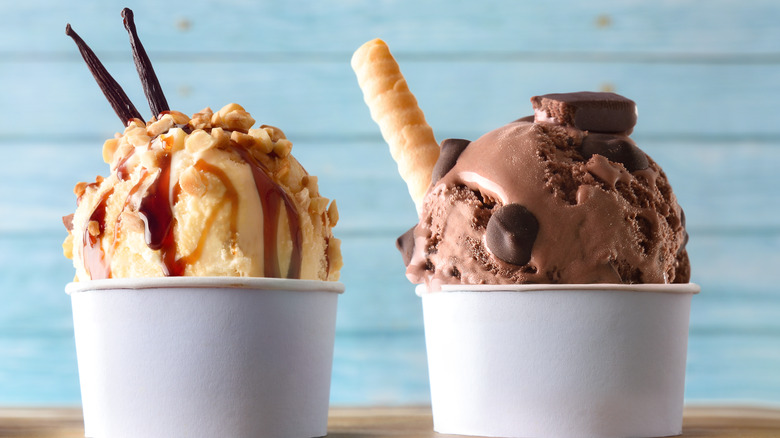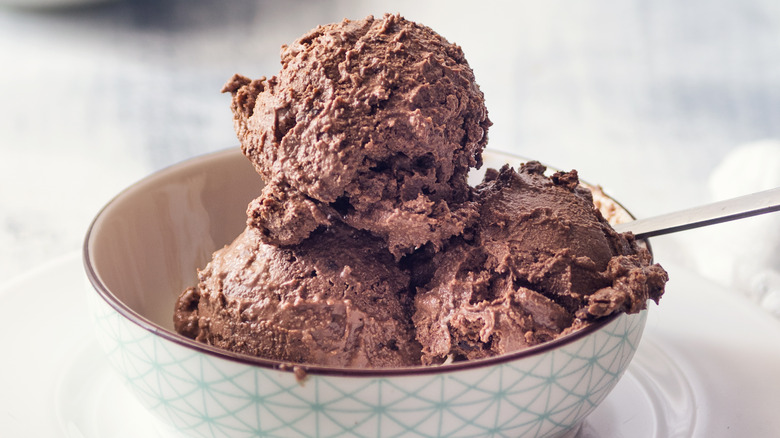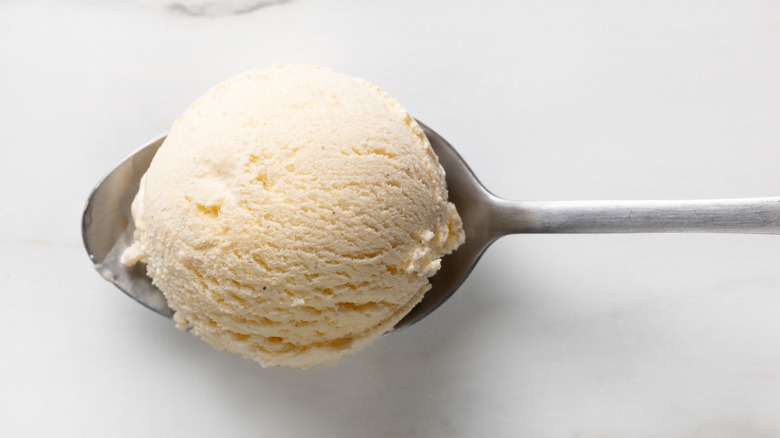What Came First, Chocolate Or Vanilla Ice Cream?
You would be forgiven for thinking that two of the most common ice cream flavors, chocolate and vanilla, were invented at the same time. If forced to pick which one came earlier, the "default" flavor, vanilla, seems the likely candidate. But surprisingly, chocolate ice cream was the frontrunner when it came to our favorite frozen treat. The explanation is a little bit historical, a little bit anthropological, and a whole lot of importing and exporting.
Ice cream's origins are murkier than vanilla or chocolate, and the frosty dessert has been around longer than you might think. Alexander the Great and Roman Emperor Nero would send soldiers and slaves into the mountains to collect snow, which was then mixed with honey and fruit pulp to make an ancient version of Italian ice or shaved ice. Many years later, Italian explorer Marco Polo brought an Asian variant of the fruity iced snack to Europe, though this was more like sherbet than ice cream.
Italian and French nobles began experimenting with iced creations, adding eggs, cream, and butter in the 17th century. English colonists then brought it to the New World, where it became popular after the Revolutionary War. Presidents Washington, Jefferson, and Madison all served ice cream at White House events and at home.
A brief history of chocolate ice cream
Chocolate was discovered in the pre-Columbian era, due to the cocoa tree's literal roots in South America. Ancient cultures, like the Mayans and Aztecs, consumed chocolate as a frothy, bitter drink in religious ceremonies and daily life. By the time European explorers landed, cocoa beans were firmly entrenched in the Americas and were used as both currency and to make spiritual elixirs. Explorers like Columbus and Cortes hastened to bring the beans and drink-making equipment back to Europe, where it quickly became the "it drink" of the upper classes. (You can still order a Mexican hot-chocolate-inspired drink from Starbucks today as a nod to the drink's cultural roots.)
Before long, cocoa beans were being imported to North America and beyond, kicking off large-scale chocolate production by the end of the 17th century. Benjamin Franklin sold chocolate out of his Philadelphia printing shop, while George Washington ordered pounds of it to serve to guests at his home in Mount Vernon. Chocolate ice cream actually made its debut about a century before vanilla, thanks to the availability of cocoa beans. Recipes for chocolate ice cream began to show up in cookbooks during the 17th century, though fruit-flavored creams were still preferred.
A brief history of vanilla ice cream
If you think vanilla is boring, you're probably eating it wrong. While often labeled as bland, vanilla actually has a fascinating history. As this exotic spice was much harder to come by before the mid-1800s, vanilla-flavored ice cream took a little longer to arrive on the gastronomy scene compared with chocolate. Similar to chocolate though, vanilla also arrived in North America via European explorers. Originating in Central America, the vanilla orchid was believed to have only one natural pollinator — the Melipona bee — although it was later shown that other native bee species could also help vanilla reproduce. It wasn't until a 12-year-old boy on a French island near Madagascar invented the tedious method of hand-pollinating the flowers that commercial cultivation of vanilla beans became possible. Incredibly, even now, most of the vanilla produced is hand-pollinated and requires a year-long process from growing to curing to exporting.
Thomas Jefferson is often given credit for bringing vanilla ice cream to the masses after his time in France exposed him to many European culinary delights. While he was lucky (and rich enough) to acquire real vanilla pods for his ice cream recipe, most of what we consume today is made using artificial vanilla flavoring. With vanilla being the second most expensive spice in the world (just behind saffron), it's pretty safe to assume your vanilla ice cream is not packing any real flecks of vanilla from a pod carefully grown in Tahiti. And yet, despite the dominance of artificial flavoring and chemical compounds, vanilla ice cream is still the biggest seller worldwide.


